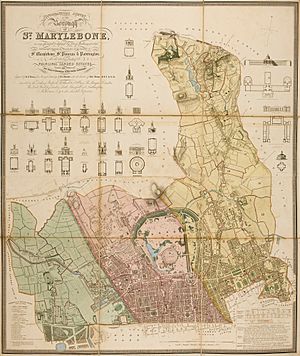Marylebone (UK Parliament constituency) facts for kids
Quick facts for kids {{{Name}}}[[{{{Type}}} constituency]] |
|
|---|---|
| [[Image:{{{Map1}}}Constituency.svg|120px|]] [[Image:England{{{Map2}}}.svg|120px|]] |
|
| {{{Name}}} shown within [[{{{Entity}}}]], and {{{Entity}}} shown within England | |
| Created: | {{{Year}}} |
| MP: | {{{MP}}} |
| Party: | {{{Party}}} |
| Type: | House of Commons |
| County: | [[{{{County}}}]] |
| EP constituency: | [[{{{EP}}} (European Parliament constituency)|{{{EP}}}]] |
Marylebone was a special area in Middlesex, England, that had its own representatives in the UK Parliament. This area was called a parliamentary constituency. From 1832 to 1885, Marylebone was part of London's growing city.
It was created in 1832 by a law called the Reform Act 1832. This law changed how people voted and how areas were represented. Marylebone sent two members to the UK Parliament. In 1885, another law, the Redistribution of Seats Act, ended the Marylebone constituency. It was then divided into eight smaller areas.
What Was the Marylebone Area?
Marylebone was one of five new parliamentary areas in London created in 1832. These areas were part of the Metropolitan area of London.
The Marylebone constituency included three main local areas, known as civil parishes:
- Saint Marylebone
- Paddington
- Saint Pancras
At first, there was a plan to leave out a part of Saint Pancras that was still mostly countryside. However, the people of Saint Pancras asked Parliament to include their whole area, and this request was accepted.
In 1885, the Marylebone constituency was split into eight new, smaller areas. Each of these new areas would send just one member to Parliament. These new areas were:
- Marylebone East
- Marylebone West
- Paddington North
- Paddington South
- St. Pancras East
- St. Pancras North
- St. Pancras South
- St. Pancras West
Who Represented Marylebone?
The Marylebone constituency always had two Members of Parliament (MPs). These MPs were elected by the people living in the area. They would then represent the views and needs of Marylebone in the House of Commons.
Over the years, MPs from different political groups were elected. These included:
- Whigs: An older political group that later became part of the Liberal Party.
- Radicals: A group that wanted big changes and reforms in politics.
- Conservatives: A political party that generally supported traditional values and less change.
- Liberals: A major political party that grew out of the Whigs and Radicals, focusing on individual freedoms and social reform.
Many elections were held in Marylebone between 1832 and 1885. Voters would choose their two preferred candidates. Sometimes, an MP would resign or leave office, which would cause a special election called a "by-election." This allowed the people to choose a new representative right away.
For example, in 1833, Edward Portman resigned, and Samuel Whalley was elected in a by-election. Later, in 1838, Whalley's election was declared invalid, and Charles Shore won the next by-election. These elections show how the people of Marylebone actively participated in choosing their leaders.


